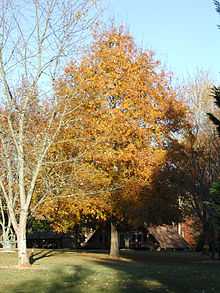Quercus phellos
| Willow Oak | |
|---|---|
 | |
| Quercus phellos in autumn foliage | |
| Scientific classification | |
| Kingdom: | Plantae |
| (unranked): | Angiosperms |
| (unranked): | Eudicots |
| (unranked): | Rosids |
| Order: | Fagales |
| Family: | Fagaceae |
| Genus: | Quercus |
| Section: | Lobatae |
| Species: | Q. phellos |
| Binomial name | |
| Quercus phellos L. | |
 | |
Quercus phellos (willow oak) is a deciduous tree in the red oak group of oaks. It is native to eastern North America from southern New York (Long Island) south to northern Florida, and west to southernmost Illinois and eastern Texas. It is most commonly found growing on lowland floodplains, often along streams, but rarely also in uplands with poor drainage, up to 400 m altitude.
Description
It is a medium-sized tree growing to 20-30 m tall (exceptionally to 39 m), with a trunk up to 1-1.5 m diameter (exceptionally 2 m). It is distinguished from most other oaks by its leaves, which are shaped like willow leaves, 5-12 cm long and 1-2.5 cm broad with an entire margin; they are bright green above, paler beneath, usually hairless but sometimes downy beneath. The fruit is an acorn, 8-12 mm long, and almost as wide as long, with a shallow cup; it is one of the most prolific producers of acorns, an important food tree for squirrels, birds, and other animals in the forest. The tree starts acorn production around 15 years of age, earlier than many oak species.
Willow oaks can grow moderately fast (height growth up to 60 cm / 2 feet a year), and tend to be conic to oblong when young, rounding out and gaining girth at maturity (i.e. more than 50 years).
Cultivation and uses
Economic uses are primarily as an ornamental tree and the wood for pulp and paper production, but also for lumber; it is often marketed as "red oak" wood.
The Willow oak is one of the most popular trees for horticultural planting, due to its rapid growth, hardiness, balance between axial and radial dominance, ability to withstand both sun and shade, light green leaf color and full crown. Despite being massively planted in the U.S. South (such as Washington, DC and Atlanta, Georgia) around malls, along roads, etc., the tree tends to grow larger than planners expect, and often leads to cracked sidewalks. One intriguing solution being tried in D.C. is to use 'rubber' sidewalks, made from recycled tires.[1]
References
External links
- Flora of North America: Quercus phellos
- US Forest Service Silvics Manual: Quercus phellos
- Fairfax County Public School Factsheet: Willow Oak
- Quercus phellos images at bioimages.vanderbilt.edu
- Interactive Distribution Map of Quercus phellos